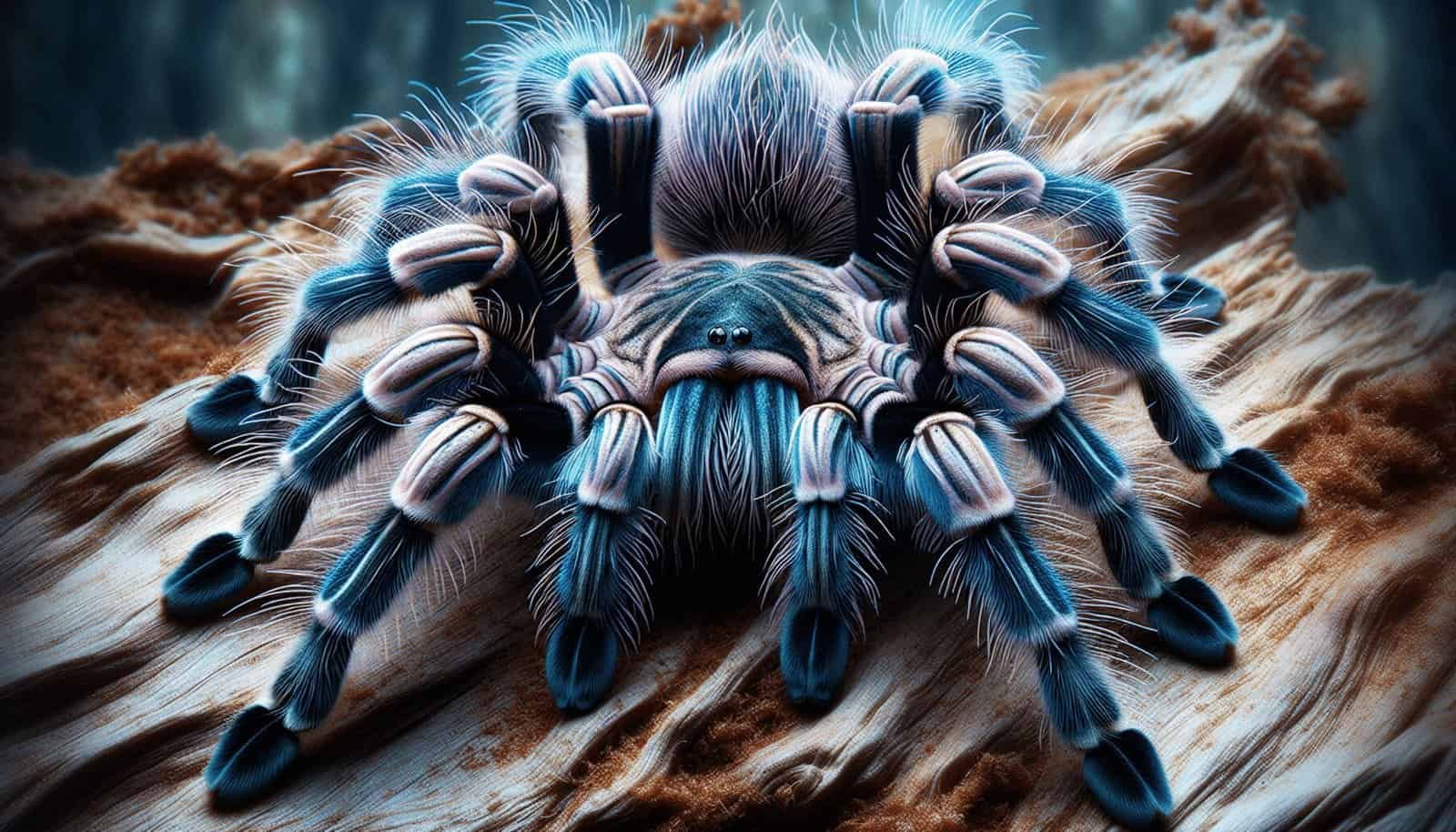Have you ever been curious about the unique and captivating world of tarantulas? If so, the Indian Violet Tarantula might just intrigue you. Known for its stunning appearance and intriguing behavior, this species can make for a fascinating pet. In this article, you’ll discover the captivating characteristics of the Indian Violet Tarantula and learn how to care for it properly as a pet.

The Indian Violet Tarantula: An Overview
The Indian Violet Tarantula, also known by its scientific name, Chilobrachys fimbriatus, hails from the lush and diverse regions of India. This species is a tropical tarantula, renowned for its fascinating coloration and behavioral traits that set it apart from other tarantulas.
Unique Appearance
One of the primary reasons people are drawn to the Indian Violet Tarantula is its striking appearance. As its name suggests, the tarantula boasts a beautiful purple hue, especially when it is illuminated under the right light. This violet sheen can vary in intensity, adding to the spider’s allure. Younger tarantulas may display a more muted coloration but will progressively develop their vibrant colors as they mature.
Behavior and Temperament
The Indian Violet Tarantula is known for its sometimes skittish and defensive behavior. While not typically aggressive, it is quick to take a defensive stance if it feels threatened. This characteristic makes it essential for prospective pet owners to understand proper handling techniques to minimize stress for both the spider and themselves. It is a highly active and industrious species, often engaging in burrowing and web-building activities.
Habitat and Housing Requirements
Creating the ideal habitat for your Indian Violet Tarantula is crucial for its health and well-being. This species has specific needs that must be met to ensure it thrives in a captive environment.
Enclosure Size
When selecting an enclosure, it is paramount to choose one that provides ample space for your tarantula to explore and build its burrows. A 10-gallon terrarium is a standard recommendation for an adult Indian Violet Tarantula. Ensure the enclosure has a secure lid to prevent any escape attempts.
| Age/Stage | Enclosure Size |
|---|---|
| Spiderling | Small plastic container |
| Juvenile | 5-gallon terrarium |
| Adult | 10-gallon terrarium |
Substrate
The substrate is the foundation of your tarantula’s habitat. A deep substrate of at least 4 inches is advisable, as this species loves to dig and create elaborate burrows. Options like coconut fiber, peat moss, and dampened soil are suitable choices.
Temperature and Humidity
Maintaining the correct temperature and humidity levels is vital. The Indian Violet Tarantula thrives in temperatures ranging from 75°F to 85°F and requires a humidity level of around 75% to 80%.
| Parameter | Optimal Range |
|---|---|
| Temperature | 75°F – 85°F (24°C – 29°C) |
| Humidity | 75% – 80% |
Decorations and Hiding Spots
Incorporate various hiding spots and decorations within the enclosure to mimic the tarantula’s natural habitat. Pieces of bark, cork, and artificial plants provide excellent hiding and climbing opportunities, contributing to your spider’s mental and physical well-being.
Diet and Feeding
Feeding your Indian Violet Tarantula the right diet is essential for its growth and health. This species primarily feeds on insects.
Suitable Food Options
Crickets, roaches, and mealworms are staple food items for the Indian Violet Tarantula. Juvenile tarantulas may prefer smaller insects like fruit flies and pinhead crickets, while adults can handle larger prey.
| Age/Stage | Suitable Food |
|---|---|
| Spiderling | Pinhead crickets, fruit flies |
| Juvenile | Small crickets, mealworms |
| Adult | Large crickets, roaches |
Feeding Frequency
The frequency of feeding varies based on the tarantula’s age and size. Spiderlings may need to be fed more frequently, around twice a week, whereas adults can be fed once a week.
Molting Process
Understanding the molting process is critical for any tarantula owner. Molting is how tarantulas grow, shedding their exoskeleton to accommodate a larger one.
Signs of Molting
Recognizing the signs of an impending molt can help you care for your tarantula more effectively. Common signs include reduced appetite, lethargy, and increased webbing around their burrow or hide.
Molting Care
During the molting process, ensure the humidity levels are at the higher end of the spectrum (around 80%) to assist the tarantula in shedding its old exoskeleton. Avoid handling or disturbing your tarantula during this sensitive period.

Health Concerns
Like any pet, Indian Violet Tarantulas can encounter health issues. Understanding these potential problems and their remedies can keep your tarantula healthy.
Common Health Issues
- Dehydration: Signs include a shriveled abdomen and lethargy. Ensure adequate humidity and provide a shallow water dish.
- Parasites: Small mites or lethargy can indicate a parasitic infection. Clean the enclosure and consult a veterinarian for treatment.
- Injury: Accidental falls or injuries from prey can occur. Provide a soft substrate and monitor interactions during feeding.
Preventative Care
Regularly check your tarantula for any signs of illness or discomfort. Keeping the enclosure clean and maintaining proper environmental conditions are proactive steps to ensure your spider remains healthy.
Interaction and Handling
Handling tarantulas can be a thrilling yet cautious experience. The Indian Violet Tarantula, given its defensive nature, requires careful and minimal handling.
Handling Tips
If you need to handle your Indian Violet Tarantula, ensure your hands are clean and free from strong scents. Move slowly and gently to avoid startling the spider. Using tools such as soft brushes can help guide your tarantula without direct contact.
Observation over Handling
Observing your tarantula’s behavior and activities from outside the enclosure is usually more beneficial and less stressful for the spider. This way, you can enjoy its fascinating behaviors without causing unnecessary stress.

Breeding the Indian Violet Tarantula
Breeding tarantulas can be a rewarding and educational experience, though it requires knowledge and preparation.
Pairing
Introducing a male and female Indian Violet Tarantula should be done cautiously. Ensure both are well-fed before pairing to reduce the chances of cannibalism. Place the male in the female’s enclosure and observe their behavior closely.
Egg Sac and Spiderlings
Once mating is successful, the female will produce an egg sac, which she guards diligently. The incubation period lasts about 6 to 8 weeks before spiderlings emerge. Remove the spiderlings and house them separately to prevent cannibalism and ensure even feeding.
Legal and Ethical Considerations
Before acquiring an Indian Violet Tarantula, consider the legal and ethical implications.
Legal Requirements
Check local laws and regulations regarding the ownership of exotic pets. Some areas may require permits or have restrictions on keeping tarantulas.
Ethical Considerations
Source your tarantula from reputable breeders or pet stores to avoid contributing to the illegal pet trade. Ethical sourcing helps protect wild populations and supports responsible pet ownership.

Conclusion
The Indian Violet Tarantula is a captivating and unique pet, offering a window into the intriguing world of exotic arachnids. By understanding their specific needs and behaviors, you can provide a healthy and enriching environment for your tarantula to thrive. With proper care and a bit of patience, keeping an Indian Violet Tarantula can be a rewarding experience, allowing you to appreciate the beauty and complexity of these remarkable creatures.